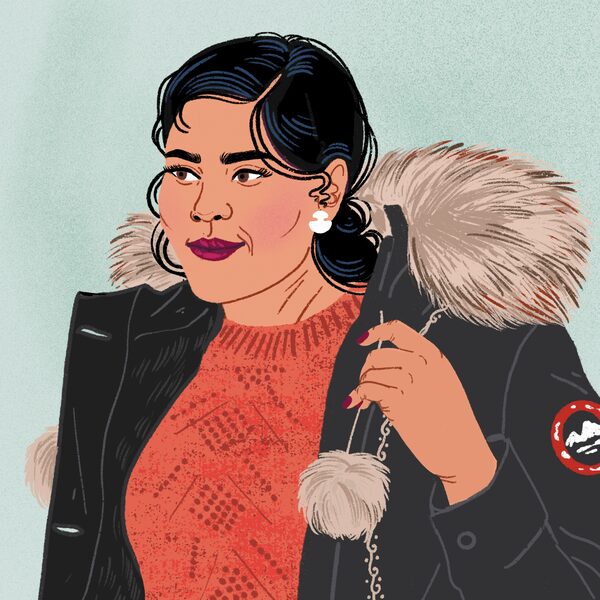
Illustration by Salini Perera
Parniga Akeeagok’s first time in New York wasn’t a typical tourist trip. While she did jet around the city to see the sights, the Iqaluit resident was primarily in town to show off her parka designs. A territorial manager with Nunavut’s government by day, Akeeagok is a passionate designer in her free time. She creates one-of-a-kind parkas, outerwear and accessories under Akulik Creations, and is part of a cohort of Inuit sewers who collaborated with Canada Goose for Project Atigi, a capsule collection of parkas designed to bring the sewing heritage of Inuit peoples – a community Canada Goose works with often – to the world stage. Akeeagok spoke to The Globe and Mail about how important sewing is to her and her community, and why it matters that her designs are now in front of a global audience.
Can you explain to me how important sewing is to Inuit culture, the tradition of the craft?
Well, our ancestors – women in particular – had to sew traditional clothing to survive in the harsh climate. You know, anywhere from -40 and colder, adjusting those clothing types for the climate we endure, you know, [the clothing] allows us to survive.
The art of parka design, is that just up to the sewer’s creativity? And I'm guessing it's still mostly women who are doing it.
Nowadays, the majority is women. But, you know, men have explored that for quite some time, for repairing. If they didn't have a partner or somebody to repair their clothing, this is something that they had to do as well. And, nowadays men are taking on that skill and making their own parkas as well.
When I look at your pieces for Akulik Creations, a lot of them look like one-off designs.
Yes, that’s something I want to say that comes with a lot of seamstresses in our territory and Inuit from all four regions [in Inuit Nunangat]. Long ago, you could determine who’s coming from what region based on their design. And today, it continues to be that way. I want to say you could pinpoint where somebody is coming from based on their coat and what team or what their interests are. So yeah, we don’t normally make two coats that are exactly the same. That’s the beauty when we’re creating our garments.
Where do you find inspiration for your designs?
My inspirations come from elders and women across Canada that are Inuit. I think it’s a motivation for each one of us. We use different trims. I mean, with traditional clothing, the design has, I want to say, evolved. We use modern ways of designing our clothing. Each person demonstrates their art in a different way. And whether we’re inspired by, you know, this artist from this region, we always put a different twist to certain things on the coat.
How did you learn about Project Atigi?
I had a few friends that were involved last year, and they inspired me to apply if there was another chance to do so. The opportunity came and I felt that this would be a great challenge and to demonstrate my skill as well. So, I saw that there was that opportunity and I went for that.
When you found out you were in the program, what was the process like to design your parka?
It is a collection where you design five parkas that are different sizes, but the same style. The thing that’s different there is, you know, the challenge there for me – and I want to say many others – is that in our culture, we use our hands as a tool to measure, and whether it be our knuckle here, our hand, you know, these were our tools to measure. We look at somebody and we size them up visually. And so using the measurements that were provided to us on a scale, like being small, medium, large, like a chart, I took those measurements and incorporated them into my patterns to create what what we had to create in our collection.
Taking into account the idea of appreciation versus appropriation, how important is that to you when you’re creating these designs for non-Inuit wearers?
This showcases Inuit culture, heritage, their skill – it educates people on a global front. I think that definitely speaks volumes in the way Canada Goose invited us and involved us, to come to our home, to see our home, how they’re showcasing each woman, each individually, and where they’ve come from, that in itself shows that somebody cares and that it’s not just for show.
What do you hope people learn about Inuit craft and design from these parkas and from this project?
I think our culture is so unique. And it shows in how we design our clothing. It demonstrates who we are. Our culture is important to us. And I think globally, when people see our art, you know, we create these things based on our climate, too. And I think it’s important to showcase that. It’s a form of educating people all over the world, where we live, where we come from.
Visit tgam.ca/newsletters to sign up for the weekly Style newsletter, your guide to fashion, design, entertaining, shopping and living well. And follow us on Instagram @globestyle.